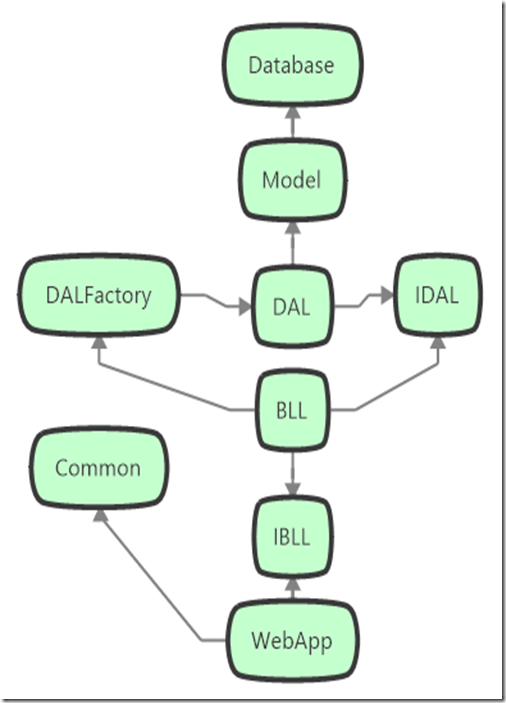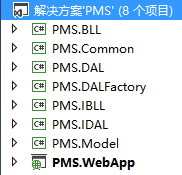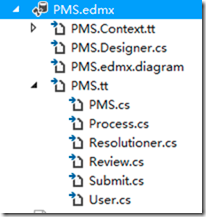新人刚开始学习ASP.NET MVC,若有不足之处希望能得到您的指点,不胜感激!
层级结构
先来一张项目的层级结构图:
![]()
Model:模型层,主要是各种类型、枚举以及ORM框架,框架完成数据库和实体类的映射。项目中选用了微软的开源ORM框架 EntityFramework 6.0 (以下简称EF),数据库则选择了微软的轻量级数据库SQL Server Compact 4.0本地数据库(简称Compact),Compact对EF支持比较完美,又属于文档型数据库,部署起来比较简洁。
DAL:数据访问层,主要是对数据库的操作层,为业务逻辑层或表示层提供数据服务。
IDAL:数据访问接口层,是数据访问层的接口,降低耦合。
DALFactory:数据会话层,封装了所有数据操作类实例的创建,将数据访问层与业务逻辑层解耦。
BLL:业务逻辑层,主要负责对数据层的操作,把一些数据层的操作进行组合以完成业务的需要。
IBLL:业务逻辑接口层,业务逻辑层的接口,降低耦合。
WebApp:表现层,是一个ASP.NET MVC项目,完成具体网站的实现。
Common:通用层,用来存放一些工具类。
下面是各个层级之间具体的实现,首先创建以 项目名.层级名 命名的各个层次,除WebApp层为ASP.NET MVC项目外,其余均创建为类库项目。
![]()
各层级搭建
模型层的构建
先建立模型层,新建ASP.NET 实体数据模型,关联到已经设计好的数据库,EF自动完成模型类的创建。
![]()
数据访问层的构建
DAL层中,我们首先需要一个方法来获取单例的EF数据操纵上下文对象,以保证每个用户访问时只有使用一个上下文对象对数据库进行操作。DbContextFactory.cs
1
2
3
4
5
6
7
8
9
10
11
12
13
14
15
16
17
18
19
20
21
| using System.Data.Entity;
using System.Runtime.Remoting.Messaging;
using PMS.Model;
namespace PMS.DAL
{
public class DbContextFactory
{
public static DbContext CreateContext()
{
DbContext dbContext = (DbContext)CallContext.GetData("dbContext");
if (dbContext != null) return dbContext;
dbContext = new PMSEntities();
CallContext.SetData("dbContext", dbContext);
return dbContext;
}
}
}
|
为User类创建DAL层,实现查询、分页查询、增加、删除和修改这五个基本的方法:UserDAL.cs
1
2
3
4
5
6
7
8
9
10
11
12
13
14
15
16
17
18
19
20
21
22
23
24
25
26
27
28
29
30
31
32
33
34
35
36
37
38
39
40
41
42
43
44
45
46
47
48
49
50
51
52
53
54
55
56
57
58
59
60
61
62
63
64
65
66
67
68
69
70
71
72
73
74
75
| using System;
using System.Data.Entity;
using System.Linq;
using PMS.IDAL;
namespace PMS.DAL
{
public partial class UserDal
{
public DbContext DbEntities = DbContextFactory.CreateContext();
public IQueryable<UserDal> LoadEntities(System.Linq.Expressions.Expression<Func<UserDal, bool>> whereLamada)
{
return DbEntities.Set<UserDal>().Where(whereLamada);
}
public IQueryable<UserDal> LoadPageEntities<TS>(int pageIndex, int pageSize, out int totalCount, System.Linq.Expressions.Expression<Func<UserDal, bool>> whereLambda, System.Linq.Expressions.Expression<Func<UserDal, TS>> orderbyLambda, bool isAsc)
{
var temp = DbEntities.Set<UserDal>().Where(whereLambda);
totalCount = temp.Count();
temp = isAsc ? temp.OrderBy(orderbyLambda).Skip((pageIndex - 1) * pageSize).Take(pageSize) : temp.OrderByDescending(orderbyLambda).Skip((pageIndex - 1) * pageSize).Take(pageSize);
return temp;
}
public bool DeleteEntity(UserDal entity)
{
DbEntities.Entry(entity).State = EntityState.Deleted;
return true;
}
public bool EditEntity(UserDal entity)
{
DbEntities.Entry(entity).State = EntityState.Modified;
return true;
}
public UserDal AddEntity(UserDal entity)
{
entity = DbEntities.Set<UserDal>().Add(entity);
return entity;
}
}
}
|
注:这里的增删改操作并不即时进行,而是在封装在数据会话层中,以实现工作单元模式,提高数据库的操作效率。
考虑到每个类都需要实现相同的数据操作,我们可以将以上方法封装到一个泛型基类中,各类型只需要继承泛型基类就可以实现以上方法:BaseDal.cs
1
2
3
4
5
6
7
8
9
10
11
12
13
14
15
16
17
18
19
20
21
22
23
24
25
26
27
28
29
30
31
32
33
34
35
36
37
38
39
40
41
42
43
44
45
46
47
48
49
50
51
52
53
54
55
56
57
58
59
60
61
62
63
64
65
66
67
68
69
70
71
72
73
74
| using System;
using System.Data.Entity;
using System.Linq;
namespace PMS.DAL
{
public class BaseDal<T> where T:class ,new()
{
public DbContext DbEntities = DbContextFactory.CreateContext();
public IQueryable<T> LoadEntities(System.Linq.Expressions.Expression<Func<T, bool>> whereLamada)
{
return DbEntities.Set<T>().Where(whereLamada);
}
public IQueryable<T> LoadPageEntities<TS>(int pageIndex, int pageSize, out int totalCount, System.Linq.Expressions.Expression<Func<T, bool>> whereLambda, System.Linq.Expressions.Expression<Func<T, TS>> orderbyLambda, bool isAsc)
{
var temp = DbEntities.Set<T>().Where(whereLambda);
totalCount = temp.Count();
temp = isAsc ? temp.OrderBy(orderbyLambda).Skip((pageIndex - 1) * pageSize).Take(pageSize) : temp.OrderByDescending(orderbyLambda).Skip((pageIndex - 1) * pageSize).Take(pageSize);
return temp;
}
public bool DeleteEntity(T entity)
{
DbEntities.Entry(entity).State = EntityState.Deleted;
return true;
}
public bool EditEntity(T entity)
{
DbEntities.Entry(entity).State = EntityState.Modified;
return true;
}
public T AddEntity(T entity)
{
entity = DbEntities.Set<T>().Add(entity);
return entity;
}
}
}
|
UserDal继承BaseDal
1
2
3
4
5
6
7
8
9
10
| using PMS.IDAL;
using PMS.Model;
namespace PMS.DAL
{
public partial class UserDal : BaseDal<User>
{
}
}
|
数据访问接口层的构建
然后我们建立相应的IbaseDal接口和IUserDal接口,并且使UserDal类实现IUserDal接口
IBaseDal:
1
2
3
4
5
6
7
8
9
10
11
12
13
14
15
16
17
18
19
20
| using System;
using System.Linq;
namespace PMS.IDAL
{
public interface IBaseDal<T> where T:class,new()
{
IQueryable<T> LoadEntities(System.Linq.Expressions.Expression<Func<T, bool>> whereLamada);
IQueryable<T> LoadPageEntities<s>(int pageIndex, int pageSize, out int totalCount,
System.Linq.Expressions.Expression<Func<T, bool>> whereLambda,
System.Linq.Expressions.Expression<Func<T, s>> orderbyLambda, bool isAsc);
bool DeleteEntity(T entity);
bool EditEntity(T entity);
T AddEntity(T entity);
}
}
|
IUserDal:
1
2
3
4
5
6
7
8
9
| using PMS.Model;
namespace PMS.IDAL
{
public partial interface IUserDal:IBaseDal<User>
{
}
}
|
UserDal实现IUserDal接口:
1
| public partial class UserDal : BaseDal<User>,IUserDal
|
数据会话层的构建
抽象工厂类AbstractFactory:
1
2
3
4
5
6
7
8
9
10
11
12
13
14
15
16
17
18
19
20
21
22
23
24
25
26
27
28
29
30
31
32
| using System.Configuration;
using System.Reflection;
using PMS.IDAL;
namespace PMS.DALFactory
{
public partial class AbstractFactory
{
private static readonly string AssemblyPath = ConfigurationManager.AppSettings["AssemblyPath"];
private static readonly string NameSpace = ConfigurationManager.AppSettings["NameSpace"];
public static IUserDal CreateUserInfoDal()
{
var fullClassName = NameSpace + ".UserInfoDal";
return CreateInstance(fullClassName) as IUserDal;
}
private static object CreateInstance(string className)
{
var assembly = Assembly.Load(AssemblyPath);
return assembly.CreateInstance(className);
}
}
}
|
数据会话类DbSession:
1
2
3
4
5
6
7
8
9
10
11
12
13
14
15
16
17
18
19
20
21
22
23
24
25
26
27
28
29
30
| using System.Data.Entity;
using PMS.IDAL;
using PMS.DAL;
namespace PMS.DALFactory
{
public partial class DbSession:IDbSession
{
public DbContext Db
{
get { return DbContextFactory.CreateContext(); }
}
private IUserDal _userDal;
public IUserDal UserDal
{
get { return _userDal ?? (_userDal = AbstractFactory.CreateUserInfoDal()); }
set { _userDal = value; }
}
public bool SaveChanges()
{
return Db.SaveChanges() > 0;
}
}
}
|
业务逻辑层的构建
业务类基类BaseService
1
2
3
4
5
6
7
8
9
10
11
12
13
14
15
16
17
18
19
20
21
22
23
24
25
26
27
28
29
30
31
32
33
34
35
36
37
38
39
40
41
42
43
44
45
46
47
48
49
50
51
52
53
54
55
56
57
58
59
60
61
62
63
64
65
66
67
68
69
70
71
72
73
74
75
76
77
78
79
80
81
82
83
84
85
86
| using System;
using System.Linq;
using System.Linq.Expressions;
using PMS.DALFactory;
using PMS.IDAL;
namespace PMS.BLL
{
public abstract class BaseService<T> where T:class,new()
{
public IDbSession CurrentDbSession
{
get
{
return new DbSession();
}
}
public IBaseDal<T> CurrentDal { get; set; }
public abstract void SetCurrentDal();
public BaseService()
{
SetCurrentDal();
}
public IQueryable<T> LoadEntities(Expression<Func<T, bool>> whereLambda)
{
return CurrentDal.LoadEntities(whereLambda);
}
public IQueryable<T> LoadPageEntities<s>(int pageIndex, int pageSize, out int totalCount, Expression<Func<T, bool>> whereLambda,
Expression<Func<T, s>> orderbyLambda, bool isAsc)
{
return CurrentDal.LoadPageEntities<s>(pageIndex, pageSize, out totalCount, whereLambda, orderbyLambda, isAsc);
}
public bool DeleteEntity(T entity)
{
CurrentDal.DeleteEntity(entity);
return CurrentDbSession.SaveChanges();
}
public bool EditEntity(T entity)
{
CurrentDal.EditEntity(entity);
return CurrentDbSession.SaveChanges();
}
public T AddEntity(T entity)
{
CurrentDal.AddEntity(entity);
CurrentDbSession.SaveChanges();
return entity;
}
}
}
|
UserService类:
1
2
3
4
5
6
7
8
9
10
11
12
13
| using PMS.IBLL;
using PMS.Model;
namespace PMS.BLL
{
public partial class UserService : BaseService<User>
{
public override void SetCurrentDal()
{
CurrentDal = CurrentDbSession.UserDal;
}
}
}
|
业务逻辑接口层的构建
直接建立对应的接口并使用UserService类实现IUserService接口
IBaseService接口:
1
2
3
4
5
6
7
8
9
10
11
12
13
14
15
16
17
18
19
20
21
22
23
| using System;
using System.Linq;
using System.Linq.Expressions;
using PMS.IDAL;
namespace PMS.IBLL
{
public interface IBaseService<T> where T : class,new()
{
IDbSession CurrentDbSession { get; }
IBaseDal<T> CurrentDal { get; set; }
void SetCurrentDal();
IQueryable<T> LoadEntities(Expression<Func<T, bool>> whereLambda);
IQueryable<T> LoadPageEntities<s>(int pageIndex, int pageSize, out int totalCount,
Expression<Func<T, bool>> whereLambda,
Expression<Func<T, s>> orderbyLambda, bool isAsc);
bool DeleteEntity(T entity);
bool EditEntity(T entity);
T AddEntity(T entity);
}
}
|
IUserService接口:
1
2
3
4
5
6
7
8
9
| using PMS.Model;
namespace PMS.IBLL
{
public partial interface IUserService:IBaseService<User>
{
}
}
|
使用UserService类实现IUserService接口:
1
| public partial class UserService : BaseService<User>, IUserService
|
以上我们就完成了整个框架中关于User类的各层次的实现。




